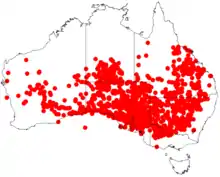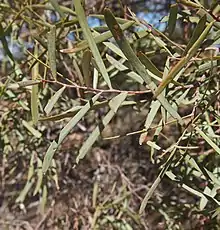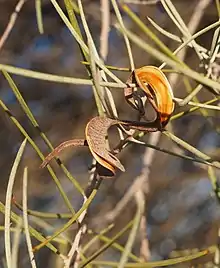Acacia oswaldii
Acacia oswaldii, commonly known as boree,[2] umbrella wattle, umbrella bush, whyacka, middia, miljee, nella and curly yarran,[3] is a shrub or tree of the genus Acacia and the subgenus Plurinerves.
| Boree | |
|---|---|
 | |
| A. oswaldii habit | |
| Scientific classification | |
| Kingdom: | Plantae |
| Clade: | Tracheophytes |
| Clade: | Angiosperms |
| Clade: | Eudicots |
| Clade: | Rosids |
| Order: | Fabales |
| Family: | Fabaceae |
| Subfamily: | Caesalpinioideae |
| Clade: | Mimosoid clade |
| Genus: | Acacia |
| Species: | A. oswaldii |
| Binomial name | |
| Acacia oswaldii | |
 | |
| Occurrence data from AVH | |
| Synonyms[1] | |
|
Acacia amaliae Domin | |


Description
The shrub or tree typically grows to a height of 1 to 6 metres (3 to 20 ft)[4] and can be found to 8 m (26 ft). It has terete and glabrous branchlets with many red, resinous micro-hairs. Phyllodes are spreading to erect with leaves that are linear, narrowly elliptic or narrowly oblong-elliptic shape that is straight to recurved, terete to flat, 2.5 to 10.5 centimetres (1 to 4 in) in length and 3 to 15 millimetres (0.12 to 0.59 in) wide.[3] Leaves are hairy when young, becoming hairless, edges smooth, with a straight often sharp point.[5]
It blooms from October to December and produces yellow flowers.[4] The simple inflorescences forms singly or in pairs in the axil of the phyllodes supported on hairy peduncles that are 0 to 1 millimetre (0.00 to 0.04 in) long. The flowers are heads globose holding 5 to 16-flowers that are 5 to 8 mm (0.2 to 0.3 in) in diameter. Seed pods form later that are curved or coiled and mostly flat except where raised over seeds. The leathery to woody pods are 4 to 25 cm (1.6 to 9.8 in) long and 5 to 12 mm (0.2 to 0.5 in) wide.[6] Seeds can be collected from March to May and sown from November to February and will germinated in 3 to 10 weeks. A. oswaldii can also be grown from cuttings.[7]
Distribution
It is native to an area in the central and southern regions of South Australia and the Northern Territory, south west Queensland, western New South Wales,[6] northern Victoria[2] and the Pilbara and Goldfields-Esperance regions of Western Australia.[4]
The distribution is wide but scattered throughout arid, semi-arid and subtropical areas in all states on the mainland, occurring mainly in calcareous sands or loamy soils.[3]
Classification
The species was initially described by the botanist Ferdinand von Mueller in 1863 in the journal Fragmenta Phytographiae Australiae.[2] Several synonyms are known including Racosperma oswaldii,[6] Acacia sessiliceps, Acacia amaliae var. amaliae, Acacia osswaldi, Acacia amaliae, Acacia oswaldi var. abbreviata and Acacia amaliae var. orthophylla.[2]
The name honours Ferdinand Oswald, who was involved with the collection of the type specimen.[6] The type specimen was collected by von Mueller in 1851 near Blanchetown on the Murray River.[3]
See also
References
- "Acacia oswaldii F.Muell. | Plants of the World Online | Kew Science". Plants of the World Online. Retrieved 2020-01-26.
- "Acacia oswaldii F.Muell. Boree". The Atlas of Living Australia. Global Biodiversity Information Facility. Retrieved 18 July 2016.
- "Acacia oswaldii". Worldwidewattle. CSIRO. Retrieved 18 July 2016.
- "Acacia oswaldii". FloraBase. Western Australian Government Department of Biodiversity, Conservation and Attractions.
- "Acacia oswaldii factsheet". Retrieved 18 July 2016.
- "Acacia oswaldii F.Muell". PlantNET. Royal Botanic Gardens, Sydney. Retrieved 12 December 2016.
- "Acacia oswaldii Umbrella Wattle". Tree Project Inc. Retrieved 18 July 2016.